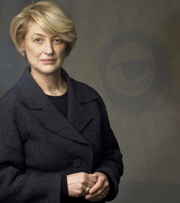
 |

|
|
 |
|
|
|||
 It was announced this week that Irene F. Whittome is one of seven winners of a Governor-General’s Award in Visual and Media Arts. The award will be presented at Rideau Hall on March 20, and carries a $15,000 cash award and a painting by one of last year’s winners. Photo by Andrew Dobrowolskyj |
by James Martin With a half-hour slide show of her work, Irene F. Whittome gave her audience a clear sense of how an artistic career is given shape by influences, symbols and hunches — provided the artist is sensitive and brave enough to make the right choices. Professor Whittome was one of the two annual Concordia University Research Fellows for 2001, an accomplishment made all the more impressive because it marks the first time the School of Graduate Studies has recognized visual arts as research. The award carries $5,000 and the opportunity to give a public lecture, which her busy artistic and teaching career did not allow her to fulfill until February 25. She began her talk with her years at the Vancouver School of Art (now the Emily Carr Institute of Art + Design). She attended the school in the early 1960s, but it wasn’t until years later that she realized its longterm subliminal impact. Pointing to a slide of the school’s logo, an eye set in the palm of an open hand, she said, “This is the base for me, one of the guiding structures. “I hadn’t realized this thing about the eye and hand at the time,” she continued, forwarding to a slide taken in 1970. She let the imagery sink in: a mixed-media piece in which found objects form a shell shape around... a print of an eye. She noted the personal impact of retroactively seeing “the source of things on a subliminal level.” The images that followed were diverse — arrangements of small glass veterinary tubes, large waxed logs, digitized prints of marine parasites — but united by a simplicity in presentation. Whittome used words such as “minimalism” and “Zen” to describe her defining aesthetic of clean refinement and stark contrasts. Another uniting precept in Whittome’s work is “communicating through objects that had had a purpose but are translated into another meaning.” Perhaps the most popular of these objects is a 1987 mold made from a leatherback turtle at the Museum of Natural Science in Ottawa. Before being purchased by the Art Gallery of Ontario (where it has disappeared from public view since its initial exhibition — “the worst place your works can go is a museum, because then they’re rarely seen again!”), the “user-friendly,” nine-foot-long reptile replica appeared in installations around the world. “What makes things really interesting is you never know what you’re communicating,” Whittome said, referring to what does, or doesn’t, resonate with an audience. “You just send it out there.” The turtle motif showed up again, albeit in miniature, in a slide of a 1994 sculpture: an oddly elegant cabinet of curiosities containing a small turtle, a book, and ostrich eggs. The next slide also united earlier ideas. “Here come the hands!” quipped Whittome as she showed a 1995 series of photographs depicting her own bound hands, a powerful visual metaphor for the artist unable to create. “It seems to have come full circle with the eye from 1970.” Whittome concluded with photos of a granite quarry, taken from her current work-in-progress. “And that’s where I am at this moment,” she said. “It’s a very exciting time.” She paused to reflect on the patterns and connections that have slowly revealed themselves over the past three decades. “It all adds up and accumulates, and that gives me the confidence that this is where I should be in the world.” Professor Whittome has taught at Concordia virtually since the beginning of her career in the late 1960s. At the same time, she steadily grew in distinction as an artist. She has had more than 35 solo art shows, notably at the Musée d’art contemporain and the Canadian Centre for Architecture, and won many awards for her work, among them, the Prix Paul-Émile Borduas, Quebec’s highest honour, and the Gershon Iskowitz Prize for excellence in the arts in Canada. |